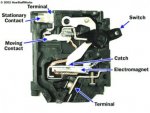Rick Christopherson
Senior Member
I was reading another discussion about high-leg delta systems and the topic turned to breaker ratings on the B-phase (high leg). For a 2-pole breaker utilizing the B-phase, it must be rated 240, not the 120/240 slash-rating. I also confirmed this in the Scheider catalog. But that's not my question.
My question is why is this the case? Why should a 2-pole breaker that is intended to see 240 volts between adjacent stabs in the load center need to care about where the grounding point is located? The circuit breaker doesn't know whether its overcurrent trip is due to a short to phase versus a short to ground. It's insulation value still has to be rated for the adjacent buss bar voltage, which is still 240 volts.
Does anyone know enough about the internals of the breaker or UL requirements to explain the difference between a 120/240 breaker versus a 240 breaker?
My question is why is this the case? Why should a 2-pole breaker that is intended to see 240 volts between adjacent stabs in the load center need to care about where the grounding point is located? The circuit breaker doesn't know whether its overcurrent trip is due to a short to phase versus a short to ground. It's insulation value still has to be rated for the adjacent buss bar voltage, which is still 240 volts.
Does anyone know enough about the internals of the breaker or UL requirements to explain the difference between a 120/240 breaker versus a 240 breaker?

